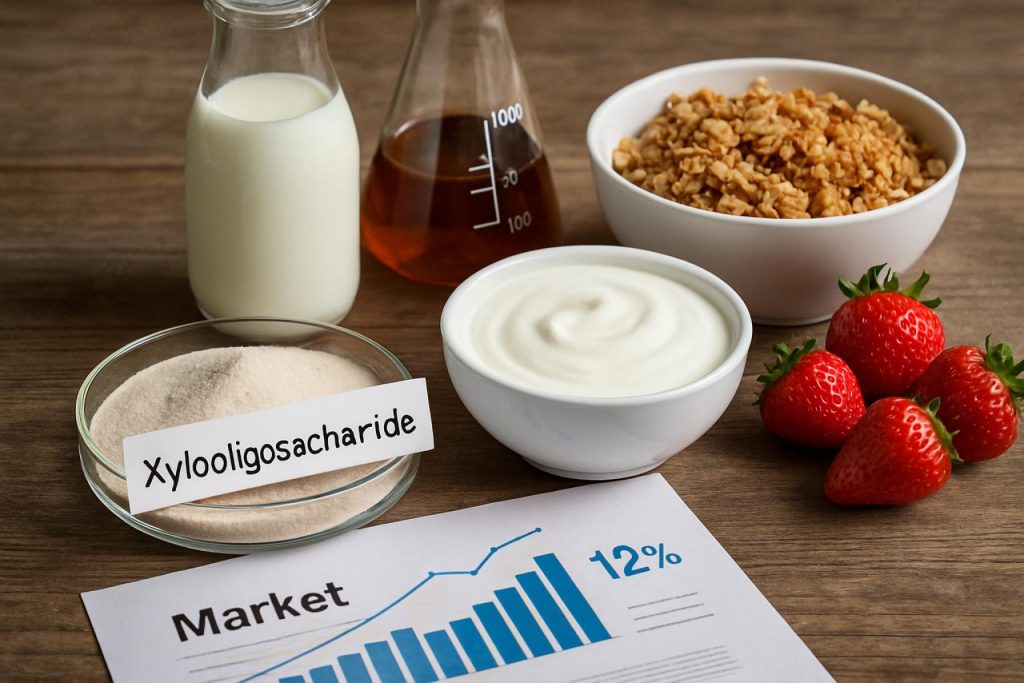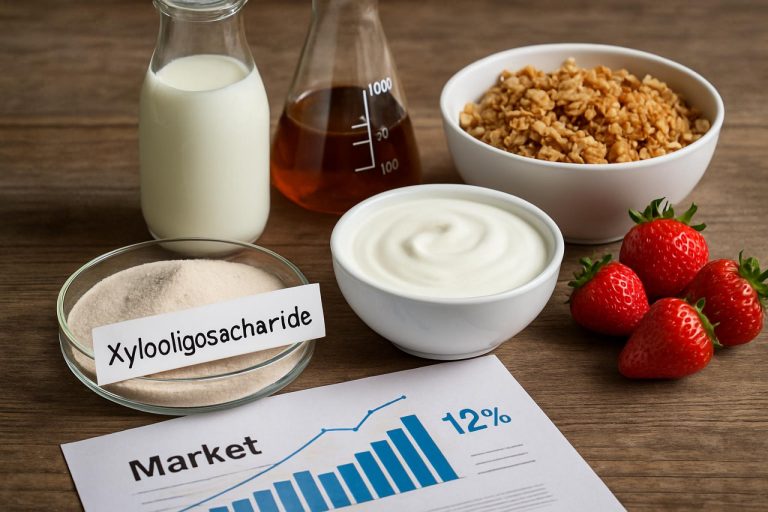
2025 Xylooligosaccharide Prebiotic Synthesis Industry Report: Market Growth, Technology Advances, and Strategic Insights for the Next 5 Years
- Executive Summary & Market Overview
- Key Technology Trends in Xylooligosaccharide Prebiotic Synthesis
- Competitive Landscape and Leading Players
- Market Growth Forecasts (2025–2030): CAGR, Volume, and Value Analysis
- Regional Market Analysis: North America, Europe, Asia-Pacific, and Rest of World
- Future Outlook: Emerging Applications and Investment Opportunities
- Challenges, Risks, and Strategic Opportunities in the Industry
- Sources & References
Executive Summary & Market Overview
The xylooligosaccharide (XOS) prebiotic synthesis industry is poised for significant growth in 2025, driven by rising consumer awareness of gut health, expanding applications in food and beverage, and ongoing advancements in biotechnological production methods. Xylooligosaccharides are short-chain sugar oligomers derived primarily from xylan-rich plant materials, and they function as prebiotics by selectively stimulating the growth of beneficial gut bacteria. The global market for XOS is expected to witness robust expansion, with estimates projecting a compound annual growth rate (CAGR) of over 8% through 2025, as reported by MarketsandMarkets.
Key drivers for the industry include the increasing prevalence of digestive health issues, a surge in demand for functional foods, and regulatory support for prebiotic ingredients in various regions. The food and beverage sector remains the largest consumer of XOS, with bakery, dairy, and beverage manufacturers incorporating these prebiotics to enhance product functionality and appeal to health-conscious consumers. Additionally, the animal feed and pharmaceutical sectors are emerging as important end-use markets, leveraging XOS for their gut health-promoting properties and potential immunomodulatory effects.
On the supply side, technological innovations in enzymatic hydrolysis and microbial fermentation have improved the efficiency and scalability of XOS production. Leading industry players are investing in research and development to optimize yields, reduce costs, and develop high-purity XOS products tailored for specific applications. For instance, companies such as DuPont and Shandong Longlive Bio-Technology Co., Ltd. are at the forefront of commercial XOS synthesis, leveraging proprietary technologies and strategic partnerships to expand their global footprint.
- Asia-Pacific dominates the XOS prebiotic synthesis market, accounting for the largest share in 2025, driven by strong demand in China, Japan, and South Korea, as noted by Grand View Research.
- North America and Europe are experiencing steady growth, supported by increasing consumer preference for clean-label and functional ingredients.
- Regulatory frameworks, such as the European Food Safety Authority’s (EFSA) positive opinion on XOS as a novel food ingredient, are facilitating market entry and product innovation.
In summary, the XOS prebiotic synthesis industry in 2025 is characterized by dynamic growth, technological progress, and expanding application horizons, positioning it as a key segment within the broader prebiotics and functional ingredients market.
Key Technology Trends in Xylooligosaccharide Prebiotic Synthesis
The xylooligosaccharide (XOS) prebiotic synthesis industry is experiencing rapid technological evolution as it responds to growing demand for functional food ingredients and gut health solutions. In 2025, several key technology trends are shaping the landscape of XOS production, focusing on efficiency, sustainability, and product quality.
- Enzymatic Hydrolysis Optimization: The industry is increasingly adopting advanced enzymatic hydrolysis methods, leveraging genetically engineered xylanases for higher yield and selectivity. These enzymes, often produced via microbial fermentation, enable the conversion of lignocellulosic biomass into XOS with minimal byproducts, reducing downstream purification costs. Companies are investing in enzyme engineering to improve thermostability and substrate specificity, as reported by Novozymes and DuPont.
- Biomass Diversification and Valorization: There is a notable shift toward utilizing agricultural residues such as corn cobs, wheat straw, and sugarcane bagasse as feedstocks. This not only lowers raw material costs but also aligns with circular economy principles. Advanced pretreatment technologies, including steam explosion and ionic liquid processing, are being deployed to enhance xylan accessibility, as highlighted by International Energy Agency (IEA).
- Continuous Processing and Scale-Up: The transition from batch to continuous processing is gaining momentum, driven by the need for consistent product quality and scalability. Automated bioreactors and inline monitoring systems are being integrated to optimize reaction parameters in real time, as seen in pilot projects by Cargill and Tate & Lyle.
- Green Chemistry and Sustainability: Environmental considerations are prompting the adoption of green solvents and energy-efficient processes. Life cycle assessments are increasingly used to benchmark the environmental impact of XOS production, with a focus on reducing water and energy consumption, according to Ellen MacArthur Foundation.
- Product Customization and Functionalization: Advances in process control allow manufacturers to tailor the degree of polymerization and purity of XOS, targeting specific prebiotic functionalities. This customization is crucial for meeting the requirements of food, beverage, and nutraceutical applications, as noted by MarketsandMarkets.
Collectively, these technology trends are positioning the XOS prebiotic synthesis industry for robust growth and innovation in 2025, with a strong emphasis on efficiency, sustainability, and market-driven product development.
Competitive Landscape and Leading Players
The competitive landscape of the xylooligosaccharide (XOS) prebiotic synthesis industry in 2025 is characterized by a mix of established biotechnology firms, specialized ingredient manufacturers, and emerging startups focused on innovative production technologies. The market is witnessing intensified competition as demand for prebiotic ingredients in functional foods, dietary supplements, and animal nutrition continues to rise globally.
Key players in the XOS prebiotic synthesis sector include DuPont (now part of IFF), Shandong Longlive Bio-Technology Co., Ltd., Yakult Honsha Co., Ltd., and Qingdao QL Biological Technology Co., Ltd.. These companies leverage proprietary enzymatic hydrolysis processes and advanced purification technologies to achieve high-purity XOS with consistent prebiotic efficacy. DuPont (IFF) has maintained a strong position through its global distribution network and robust R&D investments, focusing on expanding XOS applications in both human and animal health.
Chinese manufacturers, particularly Shandong Longlive Bio-Technology and Qingdao QL Biological Technology, dominate the supply side, benefiting from cost-effective production, access to abundant lignocellulosic feedstocks, and government support for biotechnology innovation. These firms have expanded their export capabilities, supplying XOS to North America, Europe, and Asia-Pacific markets. Their competitive advantage lies in scalable production and the ability to offer customized XOS grades for different end-use industries.
Meanwhile, Japanese companies such as Yakult Honsha focus on high-quality, research-backed XOS products, often targeting the premium segment and leveraging clinical studies to support health claims. This approach has enabled them to build strong brand recognition and partnerships with global food and beverage manufacturers.
The industry is also seeing the entry of smaller, innovation-driven firms exploring novel synthesis routes, such as enzymatic conversion of agricultural byproducts and green chemistry approaches. These entrants are challenging incumbents by offering sustainable, non-GMO, and organic-certified XOS, catering to evolving consumer preferences.
Strategic collaborations, licensing agreements, and mergers and acquisitions are common as companies seek to expand their technological capabilities and global reach. The competitive landscape in 2025 is thus marked by both consolidation among leading players and dynamic innovation from new entrants, shaping the future trajectory of the XOS prebiotic synthesis industry.
Market Growth Forecasts (2025–2030): CAGR, Volume, and Value Analysis
The global xylooligosaccharide (XOS) prebiotic synthesis industry is poised for robust expansion between 2025 and 2030, driven by increasing demand for functional food ingredients and heightened consumer awareness of gut health. According to projections by MarketsandMarkets, the XOS market is expected to register a compound annual growth rate (CAGR) of approximately 8.5% during this period. This growth is underpinned by the rising incorporation of XOS in dietary supplements, beverages, and animal feed, as well as ongoing research into its health benefits.
In terms of market value, the global XOS prebiotic synthesis industry is forecasted to reach nearly USD 200 million by 2030, up from an estimated USD 120 million in 2025. This value growth is attributed to both volume expansion and a gradual increase in average selling prices, as manufacturers invest in advanced synthesis technologies and product purity improvements. The volume of XOS produced is projected to surpass 30,000 metric tons by 2030, reflecting a steady rise in adoption across food and beverage applications, particularly in Asia-Pacific and North America.
Regionally, Asia-Pacific is anticipated to maintain its dominance, accounting for over 40% of global XOS demand by 2030, fueled by the rapid growth of the functional food sector in China, Japan, and South Korea. North America and Europe are also expected to witness significant growth, with a CAGR of 7.5% and 7.2% respectively, as regulatory approvals and consumer interest in prebiotics continue to rise (Grand View Research).
- Key growth drivers: Increased R&D investments, expanding applications in nutraceuticals, and favorable regulatory frameworks.
- Challenges: High production costs and limited raw material availability in certain regions may temper growth rates.
- Opportunities: Technological advancements in enzymatic synthesis and the development of novel XOS-based formulations are expected to unlock new market segments.
Overall, the 2025–2030 outlook for the XOS prebiotic synthesis industry is highly positive, with sustained double-digit growth in emerging markets and a gradual shift toward high-purity, specialty XOS products in developed economies (Fortune Business Insights).
Regional Market Analysis: North America, Europe, Asia-Pacific, and Rest of World
The global xylooligosaccharide (XOS) prebiotic synthesis industry is experiencing dynamic growth, with regional markets exhibiting distinct trends and drivers. In 2025, North America, Europe, Asia-Pacific, and the Rest of the World (RoW) each present unique opportunities and challenges for XOS manufacturers and suppliers.
- North America: The North American market is characterized by a strong focus on functional foods and dietary supplements, driven by increasing consumer awareness of gut health and prebiotics. The United States leads regional demand, supported by robust R&D investments and a favorable regulatory environment for novel food ingredients. Key players are leveraging advanced biotechnological synthesis methods to improve yield and purity, catering to both food and nutraceutical sectors. According to Grand View Research, North America is expected to maintain steady growth, with the U.S. accounting for the majority of market share due to its established health and wellness industry.
- Europe: Europe’s XOS prebiotic synthesis industry is propelled by stringent food safety regulations and a mature functional food market. The region’s emphasis on clean-label and non-GMO ingredients aligns well with XOS’s plant-based origin. Countries such as Germany, France, and the UK are at the forefront, with manufacturers focusing on sustainable production processes. The European Food Safety Authority’s (EFSA) positive stance on prebiotic claims further supports market expansion. Euromonitor International notes that European consumers are increasingly seeking products with scientifically backed health benefits, bolstering demand for XOS-enriched foods and beverages.
- Asia-Pacific: Asia-Pacific is the fastest-growing region for XOS prebiotic synthesis, fueled by rising health consciousness, urbanization, and a burgeoning middle class. China and Japan dominate production and consumption, with local companies investing in cost-effective synthesis technologies and large-scale manufacturing. The region benefits from abundant agricultural feedstocks, such as corn cobs and sugarcane bagasse, which are used as raw materials for XOS extraction. According to Mordor Intelligence, Asia-Pacific’s market is expected to outpace other regions in terms of CAGR through 2025, driven by both domestic demand and export opportunities.
- Rest of World (RoW): The RoW segment, including Latin America, the Middle East, and Africa, is in the nascent stages of XOS market development. Growth is primarily supported by increasing adoption of functional foods and gradual improvements in food processing infrastructure. However, limited consumer awareness and regulatory challenges may temper short-term expansion. Nonetheless, multinational companies are exploring partnerships and joint ventures to tap into these emerging markets, as highlighted by Fortune Business Insights.
In summary, while North America and Europe offer stable, innovation-driven markets, Asia-Pacific stands out for its rapid expansion and resource advantages. The Rest of the World presents long-term potential as awareness and infrastructure improve, making regional strategies crucial for stakeholders in the XOS prebiotic synthesis industry in 2025.
Future Outlook: Emerging Applications and Investment Opportunities
The future outlook for the xylooligosaccharide (XOS) prebiotic synthesis industry in 2025 is marked by robust growth prospects, driven by expanding applications and increasing investment activity. As consumer awareness of gut health and functional foods intensifies, XOS is gaining traction as a preferred prebiotic ingredient due to its superior stability, low caloric value, and selective stimulation of beneficial gut microbiota.
Emerging applications are expected to diversify beyond traditional food and beverage sectors. In 2025, XOS is poised to see increased integration into nutraceuticals, dietary supplements, and even pet nutrition, as research continues to validate its health benefits. The pharmaceutical industry is also exploring XOS for its potential in modulating immune responses and supporting metabolic health, opening new avenues for product development and clinical research. Additionally, the use of XOS in cosmetic formulations is being investigated for its skin microbiome-balancing properties, reflecting a broader trend toward microbiome-friendly personal care products.
On the production side, technological advancements in enzymatic synthesis and biorefinery processes are expected to enhance yield, purity, and cost-effectiveness. Companies are investing in green and sustainable manufacturing methods, leveraging agricultural byproducts such as corn cobs and sugarcane bagasse as feedstocks. This not only reduces production costs but also aligns with global sustainability goals, making XOS an attractive ingredient for eco-conscious brands and consumers.
- Strategic Partnerships and M&A: The industry is witnessing increased collaboration between ingredient manufacturers, food companies, and research institutions. Strategic partnerships and mergers & acquisitions are anticipated to accelerate innovation and market penetration, as seen in recent deals involving leading players like DuPont Nutrition & Biosciences and Yakult Honsha Co., Ltd..
- Venture Capital and Private Equity: Investment from venture capital and private equity firms is rising, particularly in startups focused on novel prebiotic formulations and sustainable production technologies. According to Grand View Research, the global XOS market is projected to grow at a CAGR exceeding 7% through 2025, underscoring investor confidence in the sector’s long-term potential.
- Regulatory Support: Regulatory agencies in key markets such as the EU, US, and Asia-Pacific are increasingly recognizing XOS as a safe and effective prebiotic, facilitating faster product approvals and market entry.
In summary, the XOS prebiotic synthesis industry in 2025 is set for dynamic expansion, fueled by emerging applications, technological innovation, and a favorable investment climate. Stakeholders who capitalize on these trends are likely to secure a competitive edge in the evolving functional ingredients landscape.
Challenges, Risks, and Strategic Opportunities in the Industry
The xylooligosaccharide (XOS) prebiotic synthesis industry in 2025 faces a complex landscape of challenges, risks, and strategic opportunities as it seeks to capitalize on the growing demand for functional food ingredients. One of the primary challenges is the high cost and technical complexity of XOS production. Efficient synthesis of XOS typically requires advanced enzymatic or chemical hydrolysis processes, which can be capital-intensive and demand stringent quality control to ensure product purity and consistency. This creates barriers to entry for smaller players and limits scalability for existing manufacturers (Grand View Research).
Supply chain risks are also significant. The industry relies heavily on lignocellulosic biomass, such as corncobs, wheat straw, and sugarcane bagasse, as raw materials. Fluctuations in agricultural output, competition for biomass from other bio-based industries, and logistical disruptions can impact raw material availability and pricing. Additionally, regulatory uncertainties regarding food safety standards and novel food approvals in key markets like the EU and China can delay product launches and increase compliance costs (U.S. Food and Drug Administration).
Despite these challenges, the industry is presented with several strategic opportunities. The rising consumer awareness of gut health and the proven benefits of prebiotics are driving demand for XOS in functional foods, beverages, and dietary supplements. Strategic partnerships with food and beverage manufacturers can accelerate market penetration and foster innovation in product formulations. Furthermore, advances in biotechnological processes, such as the use of genetically engineered enzymes and integrated biorefineries, offer the potential to reduce production costs and improve yields (MarketsandMarkets).
- Investment in R&D to optimize enzymatic hydrolysis and downstream purification can enhance competitiveness.
- Geographic expansion into emerging markets, where demand for functional foods is rising, represents a significant growth avenue.
- Collaboration with regulatory bodies to streamline approval processes can mitigate compliance risks and accelerate time-to-market.
In summary, while the XOS prebiotic synthesis industry in 2025 must navigate technical, supply chain, and regulatory hurdles, it is well-positioned to leverage innovation and strategic alliances to capture expanding market opportunities.
Sources & References
- MarketsandMarkets
- DuPont
- Grand View Research
- International Energy Agency (IEA)
- Tate & Lyle
- Ellen MacArthur Foundation
- Yakult Honsha Co., Ltd.
- Fortune Business Insights
- Euromonitor International
- Mordor Intelligence



